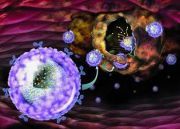Article
Nanotechnology Applications in Immunology and Allergy
Author(s):
Successful applications of nanotechnology in the field of immunology will enable new generations of vaccines, adjuvants, and immunomodulatory drugs that aim to improve clinical outcomes in response in a range of infectious and non-infectious diseases.

Nanotechnology uses the unique properties of objects that function as a unit within the overall size range of 1-1,000 nanometres (nm). During a presentation at the 2014 Annual Meeting of the American Academy of Allergy, Asthma & Immunology, held February 28 — March 4, 2014, in San Diego, CA, renowned authority on the application of nanotechnology to immunology and allergy James R. Baker, MD, pointed out that biology is inherently a nanoscience. For example, proteins and viruses are in the 1-100 nm nanoscale range. Certain synthetic nanoparticles, called dendrimers, have a regular globular structure which is reminiscent of viruses, which are approximately 50 nm in diameter.
Baker, who is the director of the Michigan Nanotechnology Institute for Medicine and Biological Sciences, University of Michigan, is one of the authors of an article on the applications of nanotechnology in immunology recently published in Nature Reviews Immunology. In the article, the authors noted that “The engineering of nanostructure materials (including nanoparticles, nanoemulsions, and nanotubules) holds great promise for the development of new immunomodulatory agents, as such nanostructures can be used to more effectively manipulate or deliver immunologically active components to target sites. Successful applications of nanotechnology in the field of immunology will enable new generations of vaccines, adjuvants and immunomodulatory drugs that aim to improve clinical outcomes in response to a range of infectious and non-infectious diseases.”
Because nanoparticles can migrate in tissue because of their size and vary in their characteristics (which is important when considering pharmacologic applications), the size, structure, and composition of nanoparticles is very important, said Baker.
Baker said that nanoparticle size plays an important role when considering barriers to the uptake of supermolecular therapeutics. For example, the pores in blood vessel walls are usually less than 50 nm in diameter, which would inhibit the passage of larger particles. Thus, drug delivery particles (eg, tumoricidal agents) must be less than 50-60 nm to pass through the blood vessel wall and enter the target tissue.
Dr. Baker’s presentation potential applications for nanoparticles in three main areas: antigen delivery and induction of innate immunity, induction of specific immune responses, and suppression of immune responses.
In terms of activation of innate immunity, Baker said nanoparticles can be used to deliver antigens and activate innate pathways. Nanoemulsions can be used to enhance delivery to the immune system compared to saline suspensions. This has been demonstrated using green fluorescent protein (GFP) delivered to the nasal epithelium in mice and also to lymph nodes.
Lipid-based nanoparticles containing quantum dots can enter the vascular epithelium without disruption except for some vacuolization followed by internalization into dendritic cells. This is an important step in activating the immune system.
Lipid nanoparticles can also act as a reserve of activity, whereas saline-based particles are more rapidly cleared. This has been shown intranasally in mice, but using red fluorescent protein (RFP).
Nanoparticles have been used to induce specific immune responses in various vaccination formulations, such as in the development of experimental RSV vaccines. The use of conventional, formalin-inactivated RSV vaccines in the 1960s led to severe Th2 cytokine-mediated eosinophilic disease, causing death in some infants.
Nanomaterials also have capabilities for suppressing immune responses by different mechanisms, such as developing nanoparticles that inhibit target cells by direct dendritic or T-cell suppression. Alternatively, nanoparticles can be used to enhance the delivery of active suppressive molecules to the cells. Experimentally, activation of Toll-like and NOD-like receptors modulates immune responses.
Baker introduced a caveat here, and noted that very small nanoparticles (< 20-30 nm) tend to be taken up by the macrophages and are not broken down during the activation process involving apoptotic bodies and dendritic cells. These small particles have been shown to stimulate granulomatosis. Granulomas formed in the lungs of experimental mice are reminiscent of those seen after exposure to particulates from diesel oil combustion.
Because of their size, the possibility of structuring them for unique purposes, and their specific uptake by immune cells, nanomaterials have unique capabilities for altering immunity. One of the most promising areas of research involves the delivery of immunosuppressive drugs to immune cells by functionalized nanoparticles.
Successful applications of nanotechnology in the field of immunology will enable new generations of vaccines, adjuvants, and immunomodulatory drugs that aim to improve clinical outcomes in response in a range of infectious and non-infectious diseases.





